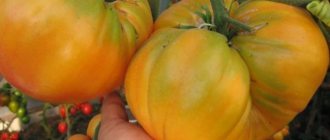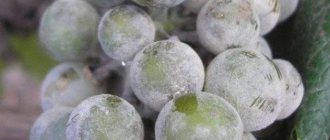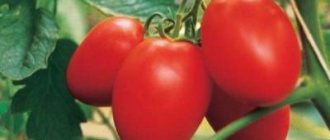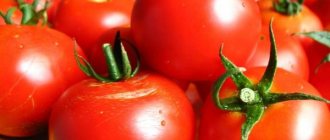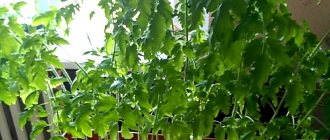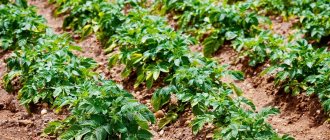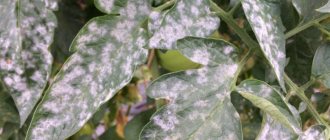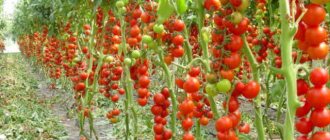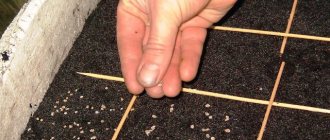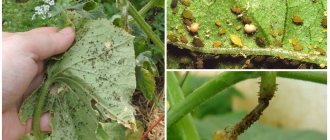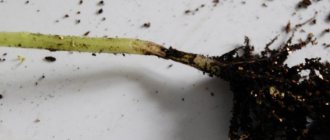Like any other crop, tomato has its own preferences for temperature indicators. They are different at different periods of life. If these features are understood, then it becomes possible to help the crop at one or another stage of development, as well as influence the size and quality of the crop (or, at least, not harm it). It is easier to use this information in a heated greenhouse. However, some knowledge will also help us, summer residents and gardeners, when growing seedlings, determining the time of planting them in the ground and further caring for tomatoes.
Tomato fruits. © qsishenzhen
The importance of temperature conditions when growing tomato seedlings
Inexperienced gardeners who want to get an early harvest sow tomato seeds as early as possible. They believe that the sooner you plant, the sooner you can enjoy the delicious fruits. But as a result, they acquire weak shoots and a lot of hassle in caring for them.
These situations arise if tomato seeds are planted very early, for example, in February. At this time, the day is short, and the air temperature is far from what the vegetable needs. For a heat-loving plant, frosts and sudden temperature changes are very dangerous.
In case of cold weather, saving the root system becomes almost impossible. Experienced gardeners recommend not to rush and plant tomato seedlings a little later - in mid-March, early April.
Air temperature
Providing seedlings with daylight and observing a special temperature regime will result in a strong and good vegetable crop. Not many people know that at each stage of growth, a tomato requires different conditions.
When planting seeds
After the tomatoes are sown in containers for seedlings, the optimal temperature for them will be 24-26 °C. The box with the culture should be covered with polyethylene.
It is better to place it on the windowsill, and put a sheet of foam underneath; the windows should be kept closed. A prerequisite must be the penetration of daylight into the room.
By following the important rules for ensuring the required temperature, you can get the first shoots 5 days after planting. As soon as the sprouts appear, the polyethylene should be removed and the foam should be left in the same place.
After germination
When seedlings appear, seedlings need to lower the air temperature. In the first 7-10 days - approximately +13...+18 °C during the day, at night +11...+14 °C. This way you can prevent the sprout from stretching, which will subsequently give a strong stem.
There are situations when seedlings cannot germinate due to a thick seed shell. Most likely this occurs due to lack of moisture.
In this case, it is necessary to moisten the soil with water at room temperature using a special sprayer. Irrigate with caution, avoiding excess moisture, otherwise the seeds may rot.
After 7-10 days in the room where tomatoes are grown, the temperature must be gradually increased:
- on clear days up to 20-23 °C;
- on cloudy days keep to 18-20 °C;
- At night, the optimal temperature will be 17-19 °C.
Experienced vegetable growers follow a slightly different regime, for example, in rainy or cloudy weather: +16...+19 °C, and at night they recommend: +10...+13 °C.
It is worth considering that a decrease in temperature by 2-3 °C can have a detrimental effect on tomato seedlings: the root system will become weak, the development of the crop will be much worse, which will affect the yield. Overheating the sprouts is also not beneficial; it causes the plant to stretch upward and, as a result, produces a thin, weak stem.
It is important to carry out this care before the first pair of leaves appears on the seedlings. To do this, 30-40 days must pass from the moment of planting.
For proper ripening of seedlings, daylight hours must be at least 10 hours, so if necessary, the plant should be provided with light with special lamps.
In addition to special heat and light conditions, seedlings need moisture. The soil should be sprayed with a spray bottle, avoiding excessive watering.
Excess liquid can provoke fungal diseases and rotting of the root system.
How to maintain thermal conditions after picking
When vegetable seeds are sown too thickly, they need to be planted. Regular half-liter plastic cups are suitable for this. It is advisable to carry out the transplantation procedure into separate containers after the first leaves appear on the seedlings.
The temperature regime is also important here, strict adherence to which will yield good results in the future.
What temperature do seedlings need after diving:
- on a clear day 20-23 °C;
- on a cloudy day 16-18 °C;
- at night 12-15 °C.
When are tomatoes harvested?
A special chemical, lycopene, is responsible for the color of the fruits of this garden crop. For it to be produced, a certain temperature is needed.
Interesting! Lycopene has antioxidant effects and suppresses the development of cancer cells.
The production of the compound is inhibited during frosts - below 10-12 ° C, and in heat - when the temperature exceeds 30 ° C, especially when the weather is calm. For active redness, the optimal weather conditions are sun, daytime temperature 18-26°C, and night temperature 12-16°C. Under unfavorable weather conditions, green fruits do not ripen and become infected with late blight. Even when the temperature is normal, but the weather is rainy, the crop is harvested before it is fully ripe.
The degree of maturity is determined by color:
- Green ones are firm, with smooth skin.
- Blange - this category includes tomatoes that are light green, brown, with individual areas of pink, reddish, yellowish-brown hues.
- Uniformly colored - pink, red, yellow. A green spot near the stalk is allowed.
Fruits with developed seeds and reaching the size corresponding to the variety are sent for ripening. If the seeds are soft, you won't be able to taste the tomatoes - they will rot.
Attention!
Tomatoes with signs of damage are destroyed, regardless of the color of the peel and the quality of the seeds. If they are left on the bush or in the installation, neighboring ones will become infected.
Open ground
The harvest is harvested if, at the end of August, cloudy weather continues steadily or at night the temperature drops below 6-7°C. If pathogenic fungi have already been activated on the plant, it is advisable to treat the fruits - immerse them in hot water (60°C) for 1-2 minutes. The fungal flora on the surface dies.
You need to monitor the water temperature and the duration of the dive. If you put it in boiling water, the skin will burst. Leave to soak - the tomatoes will be saturated with liquid. Before laying for ripening, the surface is wiped dry. In order not to lose the harvest in cases where they come to the site from time to time, harvesting is carried out at stable nighttime drops in temperature to 10°C and upon reaching milk maturity.
In the greenhouse
In order for all the tomatoes to ripen in the greenhouse during daily night frosts, they are picked brown. It must be taken into account that more capricious varieties are grown under frames. The critical temperature for them will be 9°C. Late-ripening ones are recommended to be collected in late August - mid-September. Of course, weather conditions must be taken into account.
Regardless of growing conditions, fruits are removed at the first signs of late blight. The collection is carried out every 3-5 days, this will help the remaining ones to form and ripen to the desired stage.
The influence of different temperatures on seedlings
At high temperatures, tomatoes quickly begin to bloom and bear fruit, but because of this, the number of fruits in the future will be much smaller. When the seedlings are placed in a place where the temperature is lower than optimal, the growth of the plant is significantly slowed down, but the result is a very good harvest.
If it differs greatly from the required parameters, the tomato bears fruit much later and rather poorly. These tomatoes have a significantly lower level of sugar and fruit acids.
Sudden temperature changes can negatively affect crop growth. When the thermometer drops to +5 °C, the plant stops developing.
You should not think that only low temperatures have a detrimental effect on seedlings; raising the temperature to +40 °C also leads to their death.
Minimum
It is important to ensure that the place where the seedlings are located has an optimal thermal regime. The mark on the thermometer should not reach +10 °C, otherwise the growth of the plant will stop. Tomatoes love heat very much, so it is recommended that the minimum value be +12 °C at night and +23 °C during the day.
Maximum
The temperature at which seedling growth stops is above 28 °C and below 13 °C. In this case, the plant's pollen is sterilized.
Red tomatoes at home
There are several ways to get ripe fruits:
- With a harvest of medium volume. Dry tomatoes are laid out in 2-3 layers on racks or in baskets (possibly in wooden boxes with loose walls). The microclimate of the room is a temperature of 20-25°C and stable ventilation (draft). It is better to turn over daily. Fruits with signs of damage on the skin are removed from the general clutch. After 2-3 days the tomatoes will turn red.
- A bountiful harvest. In this case, ripening is long, up to 40 days, but everything will turn red evenly. Fruits are laid out in boxes, baskets or paper boxes in layers - 2-3, but lined with dry sawdust and paper (preferably wrapping paper). Cover loosely with a lid or cloth. Store at humidity 80-85% and temperature 14-15°C. If you need to speed up redness, 2-3 tomatoes from the stack are transferred to the windowsill.
The fruits are cut from the bushes, keeping the stalk, with brushes, retreating 1-1.5 cm. If there are no signs of damage, it is not necessary to immerse them in water. It is enough to wipe the skin with a dry napkin or rag to remove dust and sand.
Ripening on the bushes
It is not necessary to cut the tomatoes. With this method, it is possible to preserve more fruits - the nutrients that have accumulated in the roots and green parts are transferred to the tomatoes:
- Dig the stems out of the bed with roots and shake off the soil. Hang them so that the fruits do not touch each other. Mandatory conditions are T 20-25°C and ventilation. During this time, they not only turn red, but also increase in size.
- They dig up bushes with a lump of earth and plant them in boxes on a glassed-in veranda or loggia. Water once every 7-8 days, remove red fruits as they ripen.
- The soil is shaken off the roots, and the bushes are placed in sheaves, with the tops inward, raised 15-25 cm above the roots. Straw is used as a lining and covering. Harvest ripe fruits every 4-6 days.
You will need:
Lecho from green tomatoes At the end of the fresh vegetable season, small green tomatoes remain in the beds. You can use them to make very tasty…
Bananas or red apples speed up the reddening process. It is enough to place them in a pack, and the tomatoes will turn red twice as sooner. If the harvest is rich, and for some reason ripening needs to be accelerated, the stacking is supplemented with 2-3 ripe tomatoes (they will have to be changed periodically so as not to burst), bright flower lamps are directed at them and the temperature in the room is raised to 28°C. In this case, you will have to sort through the fruits every day - the risk of spoilage increases.
Rules for adjusting the optimal air temperature
Creating favorable conditions for tomato seedlings is quite troublesome when it comes to indoors. In cloudy weather, you can use heating and special lamps. Also, do not forget about foam plastic, which can be used to wrap a box with sprouts. The top of the plants can be covered with polyethylene or other material, but only so that it allows daylight to pass through.
In a greenhouse, the temperature can be controlled using daylight. If it increases, ventilation is used. Thanks to this, you can get a better and earlier harvest.
Soil temperature
If the plant is in cool soil, its growth is significantly reduced. The sprouts take root poorly, wither, and the root system begins to freeze. Even if the seedling moves away, it will subsequently be vulnerable to various diseases, which will significantly add to the hassle of care.
Too warm soil is also not the best option; the plant begins to wither. This can be indicated by a thin stem and yellow leaves.
With proper care, the seedlings can be restored, but in the future this will affect fruiting.
When the bushes are planted according to the specified parameters, the tomato is accepted in the new place as quickly as possible.
Optimal temperature
The soil temperature in which the tomato develops and bears fruit quite well is 20-22 °C. It is recommended not to rush to plant seedlings in a permanent habitat until the soil temperature is as close as possible to the desired value.
Maximum
Above 30 °C and below 12 °C, it helps to stop the proper development of seedlings - the pollen becomes sterile.
Minimum
The minimum temperature allowed for planting seeds is 18 °C. For seedlings - no lower than 16 °C, otherwise the plant will poorly absorb phosphorus and nitrogen, the root system will stop developing, which will result in the death of the sprouts.
What happens to seedlings when the temperature regime is violated
Unsuitable conditions for seedlings entail many problems with the plant: from instability to diseases and pests to a meager harvest.
Low temperatures cause the stem to thicken and reduce its growth, which is not good. With a significant increase in temperature, the sprouts exhibit an elongated stem and small, pale leaves.
How does low soil temperature affect seedlings?
A slight reduction is sometimes beneficial for the tomato. In this way, you can get the correct development of the root system, which will affect the harvest in the future. The maximum period allowed for reducing the temperature is from one to two weeks.
Planting seedlings at low temperatures risks stopping the supply of nutrients to the root system. In case of severe frosts, the plant may die. If the cold weather cannot be avoided, then you can create a special shelter on the arcs. Sometimes summer residents use ordinary plastic bottles, but this method is only suitable if the cold snap is temporary. With a regular drop in temperature, unfortunately, the death of the plant cannot be avoided.
Effect of high temperature
Prolonged heat deprives the tomato of vitality, dries out the soil and slows down the growth of the bush. Often the plant begins to hurt, for example, with blackleg.
Below are some ways to save tomatoes under these conditions:
- create shelter from the sun;
- do not let the soil dry out, moisten it regularly;
- use the mulching method (lay mown grass around the sprout in a layer of 5 cm).
How to grow seedlings in open ground
To harvest a good harvest of tomatoes of any variety both in a greenhouse and in open ground, you need to make loose soil that contains a lot of nutrients and moisture.
Slightly acidic soils are best, but tomatoes will grow well in neutral soils.
But you won’t get fruit on acidic soil.
Preparing the soil should begin at the end of summer. In the selected area, dig up the soil to a depth of 20 cm and apply fertilizer. You should also dig up the soil in the spring right before planting tomatoes. In this case, it is also necessary to add nutrients to the hole.
Next, the seedlings need to be removed from the container and placed in the hole.
It is important not to touch the lump of earth formed near its root system.
After planting the tomato, they are sprinkled with compost so that the plant takes root better. The soil around the bush is compacted and watered at the rate of two liters per bush. It doesn’t matter where the tomatoes will grow - in a greenhouse or open ground, pegs to support the bush must be installed in both cases. The height of the peg is selected based on the variety of tomatoes. Instead of vertical sticks, you can use a wire arc to which the seedlings are tied.
Despite the fact that tomatoes love moisture, the planted seedlings should not be watered until you are sure that all the plants have taken root well in the open ground. It usually takes about 10 days. Watering is carried out directly under the root of the tomato, while avoiding water getting on the leaves of the crop.
Watering should be done in the afternoon so that the roots of the plant can absorb the moisture. If you water the crop during the day, the water can quickly evaporate. Tomatoes need especially intensive watering after fruiting.
It is important to note that tomatoes are extremely sensitive to sunlight. If they become deficient, they may begin to wither. Therefore, if you notice a wilted bush without any apparent cause of illness and with timely watering, you need to open the space even more to sunlight.
After watering, you should loosen the soil to a depth of 12 cm each time, removing weeds. This will allow the earth not only to warm up better, but also improve oxygen exchange.
